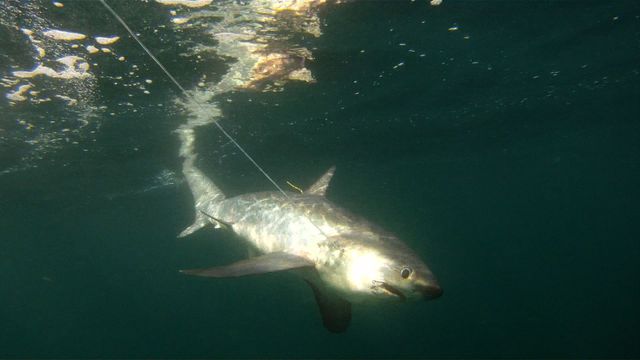An endangered or threatened species listing may be warranted for the common thresher shark, the National Marine Fisheries Service says. ADVERTISING An endangered or threatened species listing may be warranted for the common thresher shark, the National Marine Fisheries Service
An endangered or threatened species listing may be warranted for the common thresher shark, the National Marine Fisheries Service says.
The federal agency is reviewing a petition filed to list the shark, Alopias vulpinus, as endangered or threatened under the U.S. Endangered Species Act. The service, which falls under the auspices of the National Oceanic and Atmospheric Administration, announced the petition in the Federal Register released March 3, starting a 90-day period to gather additional scientific and commercial input to assist in its review.
The thresher shark is a large, highly migratory pelagic species that lives in temperate and tropical seas worldwide, including Hawaiian waters. It can live between 15 and 50 years and grow to 18 feet, according to the service.
Friends of Animals filed the petition in August 2014 to have the entire species or six distinct population segments of it be listed as endangered or threatened. A species is listed as “endangered” if it is in danger of extinction throughout all or a significant portion of its range, and “threatened” if it is likely to become endangered in the foreseeable future throughout all or a significant portion of its range, according to the 1973 act.
The group says such protection is necessary because the thresher shark faces threats from historical and continued fishing for both commercial and recreational purposes; has a limited ability to recover from fishing pressure that makes the species vulnerable to overfishing; and there few laws to protect it.
The service said it found “substantial scientific or commercial information indicating that the petitioned action may be warranted for the species worldwide” prompting a full review of the status of the common thresher shark. The group failed to present the same information to support the existence and thus protection of the six distinct population segments.
The service also acknowledged that the thresher shark historically has been overfished. However, regulations in effect since the 1990s have contributed to the rebound of the species in some areas, it said.
“Trends throughout the Eastern Pacific Ocean portion of the species’ range suggest that the population there is rebuilding from historical overexploitation. However, across the rest of its global range, we find evidence suggesting that population abundance of common thresher sharks has continued to decline or, as in the Northwest Atlantic Ocean, may be stable at a diminished abundance,” the service wrote.
Since the petition was submitted to the service, however, the common thresher shark has been listed in Appendix II under the International Convention on the Conservation of Migratory Species of Wild Animals. Such listing encourages international cooperation toward conservation of the species, the service said.
The National Marine Fisheries Service has 12 months from the time it received the petition to conclude a review with a finding of whether a petitioned action is warranted.
Comments, which must be identified by “NOAA-NMFS-2015-0025,” are due by May 4. They can be submitted online at https://www.regulations.gov/#!docketDetail;D=NOAA-NMFS-2015-0025 or via mail to Office of Protected Resources, NMFS, 1315 East-West Highway, Silver Spring, MD, 20910.



